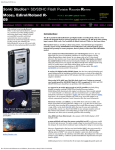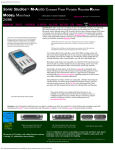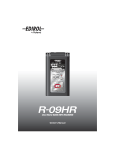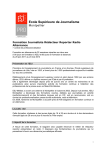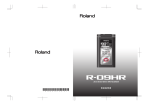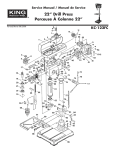Download Edirol R1 Specifications
Transcript
DSM HRTF Mic Power & Bass Filter Page Sonic Studios™ MIC POWER & FILTERS #1 'Plug-in-Power' Direct Deck Power Edirol R-09HR MOD-4 /R-09 Marantz PMD620 MOD-3 Click to find us on YouTube!!! There are 3 ways to power DSM™ microphones #2 #3 Modules & Filters MIC PREAMP Power Module TIPS Microtrack/Zoom H4 TIPS Filter Advisory This Page as Adobe Acrobat Reader PDF DOWNLOAD BATTERIES INTRODUCTION: DSM mic powering is unlike other electret type microphones commonly available as mono, single point stereo, binaural sets, and phantom powered condenser mics. These commonly require HIGH voltage, LOW current powering for best performance. DSM -1S/6S series microphones require UNIQUE LOW voltage, HIGH current condenser capsule powering. Please be aware that DSM mics special powering requirement is NOT met using other mic manufacturer's powering solutions. These are ONLY designed for typical electret microphones, and NOT compatible for use with DSM microphones. However, just applying typical (9 volt battery) power of 5-to-10 volts, LOW current common for electret powering of conventional mics WILL DO NO HARM to DSM mic sets; it just doesn't work so well. WARNING: Accidental application of high (12- 48) VOLTS PHANTOM POWERING WILL DESTROY DSM MICS UNLESS PROTECTED by special circuitry. Special protection circuitry is found inside PA-10PFC powering adapter, and special passive microphone connector adapters meant for protecting mics connected to dual 1/4" TRS and XLR balanced inputs featuring 1248 volt Phantom Power. INTERNAL DECK MOD 2 & 3 & 4 Sometimes deck models allow directly connected DSM 'plug-in-mic' power! 1) The simple and most direct DSM powering uses the mic 'Plug-in-Power' *feature normally found on most Sony/Sharp MD / Sony DAT, AND Sony PCMD50/M10 / Edirol R1 / R-09 / R09HR / Marantz PMD-620 flash decks, and some camcorders with powered minijack mic inputs. 2) Most decks with low voltage electret type mic powering feature (but NOT 12-48 volt 'phantom power') will operate a DSM mic in 'more or less' OK fashion. (but not all) IN OTHER WORDS: Nothing beats the convenience, and other direct connection benefits of just plugging the mic into the deck's mic input jack to record. This is the most convenient file:///D|/Sonicweb%20Dreamweaver%20Edition_Recent/pa_x.htm[4/3/2010 12:43:52 PM] The DSM mic is directly plugged into the deck's mic MiniStereo input jack for mic signal and mic power connection with 'plug-inpower' featured recorders. When the deck's mic input cannot properly power the DSM mic, installation of MOD2/MOD-3/MOD-4* powering upgrade (for D100/M1 DAT & R-09/R09HR/PMD-620 models only), or use of an appropriate PA adapter model is suggested. If deck has noisy mic preamplifier, and is being used for recording acoustic sources, then suggest DSM HRTF Mic Power & Bass Filter Page 'all-in-one-deck' + DSM mic portable recording system Correct, direct DSM powering as purchased stock EXCEPTIONS are SONY's PCM-D50 and LATEST PCMM10 models. These two flash deck models POWER DSM MICS PERFECTLY, AND have adequately quiet internal mic preamplifier !!!! WHAT IS MOD-2 UPGRADE for Sony DAT Models?: The upgrade places additional surface mounted components (SMC) 'in-tandem' with the existing Sony circuit to boost the mic supply performance specific to DSM mic powering. Nothing else is changed AND Sony has honored (to this date) all warranty/services agreements regardless of having this upgrade installed. I did have only two occasions (in 10 years) where there was need to send Sony the upgrade's technical details describing the true scope of the upgrading procedure in response to a temporary denial of honoring an extended warranty service contract. SONY DAT decks are sent here; 48 hour turnaround for MOD-2 service upgrade. for noise-free results an external PA-3SX or PA-24NJ preamp for both powering the mic, and improving the audio quality/versatility over common noisy, gainlimited internal deck preamps. NOTE: MOD-2 doesn't affect warranty, serviceability, or shorten the battery running time by more than a few minutes. Typical MOD-2 mic powering battery drain is LESS THAN 1/150th of the total deck power. MOD-2 upgrade is $125 USD for TCD-D100 & PCM-M1 DAT. EDIROL R-09/R-09HR & MARANTZ PMD-620 MOD-3/4 DSM POWERING UPGRADE R-09 was the first,then PMD-620, and now my current favorite Edirol R09HR flash models are practical for internal mic power circuitry upgrade for direct 'plug-in-mic-powering' of DSM™ mics. STOCK R-09, R-09HR, PMD-620 are NOT compatible for working direct connection powering of DSM microphone; TOO much current is applied causing mic to not operate. MOD-3/4 internal deck upgrade increases current control so DSM mic operates simply plugged into the MIC minijack input. Mic power is then turned on using the deck's menu. MOD-3/4 is recommended for recording applications needing simplicity of lowest profile/size of deck+mic two piece recording gear where internal noise performance of the deck is not an issue. Having R-09, R-09HR, or PMD-620 upgraded is suggested for recording moderate low-to-extreme loudness ambient/effects, and musical sounds. And when the modest noise performance of deck's internal mic preamplifier is found adequate for the intended purpose. MOD Upgrade Service file:///D|/Sonicweb%20Dreamweaver%20Edition_Recent/pa_x.htm[4/3/2010 12:43:52 PM] DSM HRTF Mic Power & Bass Filter Page R-09/R-09HR: $150 USD + Shipping R-09 + MOD-3 Upgrade + DSM-6S/EL stereo mic might be THE most compact, highest quality, and longest running 2-PIECE BLUES/POP/ROCK recording system available. (if outside USA) PMD-620: $125 USD + Shipping (if outside USA) NOTE: MOD-3 upgrade service ONLY; R-09 deck and DSM mic shown above NOT included R-09HR MOD-4 DSM POWERING UPGRADE $150 USD INCLUDES USA SHIPPING While LINE input using external PA-3SX preamplifier (shown here) both powers DSM mics, and removes virtually all noise/audio quality concerns, there's logistical, cost advantage to having a simpler deck+mic 2-piece recording rig. MOD-4 internal deck modification allows full performance DSM mic powering for having the most compact high definition recording system possible. Usual past mic powering MOD-1/2/3 did little or nothing in reducing deck mic input noise issues if any existed for a particular deck model. R-09HR using MOD-4 is different in also reducing this deck's micpower ON excessive/audible low frequency noise to be virtually identical to the mic-power OFF noise level. DRILL DEEPER INTO MOD-4 AND CUSTOM GEAR MODIFICATION IN THIS TS THREAD NOTE: The following few 'blue colored' sections mostly discuss vintage recorders not usually in service these days, but may be of interest to a few recordists who still own or find these models on the used market.. Edirol R1 solid state recorder (out of production), TCD-D7/D8 DAT deck models, (and SBM-1 Accessory; ALL out of production) have low current for DSM powering. However, these models are still OK to directly power a DSM mic in a consistent manner without external mic powering solutions, but marginal powering performance of these decks is suggested mostly for lower audio quality requirements. (NOTE: R1's internal preamplifier is also a bit too noisy for most low loudness 'natural acoustic' sounds.) EXCEPTION IS SONY PCM-D50 AND LATEST PCM-M10 as ONLY two STOCK flash decks to FULLY POWER DSM MICS CORRECTLY. This is NOT true for TCD-D100/PCM-M1 models (out of production) ALWAYS requiring MOD-2* upgrade for consistent low distortion recording for ability to use direct-connected mic powering method. TCD-D100/PCM-M1 mic powering feature is unique in being way, way 'too low in supply current' for consistent DSM mic powering. NOTE: Sony SBM-1 Portable Digital Processor DAT accessory & MZR30/37/50/55/90 MiniDisc recording decks mostly DO NOT require MOD-2 as the stock mic powering is a little weak, but good enough for consistent DSM recording quality. This is NOT true of later Sony MD models often with too little available mic power for consistent DSM mic performance. file:///D|/Sonicweb%20Dreamweaver%20Edition_Recent/pa_x.htm[4/3/2010 12:43:52 PM] MOD-2* and newer MOD3/4 direct mic powering are internal deck upgrades now only available for TCDD100 & PCMM1 Sony DAT, and Edirol/Roland R-09/R-09HR, Marantz PMD620 flash decks. ALSO, PA-3SX preamp provides simple DSM powering, and most advanced precision DSM mic powering is found in all PA-24 series of portable mic preamplifier. DSM HRTF Mic Power & Bass Filter Page Just plugging-in a DSM mic into 'most' Sony MD/DAT, and Edirol (talking R-1 only) miniportable recorders will allow a DSM "to operate" (like you'll be able to record), but performance varies from sufficiently OK to NOT OK manner sometimes causing distorted (or indeterminate) performance at unexpected times if the deck is under-powering the mic set. While the 1.5-2.5 volts available at the mic jack in Sony decks is fine for full performance with DSM (but NOT for ordinary electrets that work best with 5-10 volts or higher), the 'direct-from-stock-deck' power issue with DSM series mics is DSM needs up to 10 times MORE 'current' or amperage than is usual for common electrets from other manufacturers. Other recorder models (like Edirol R-1, Aiwa, and Sony/Canon camera) with mic 'plugin-power' features are again, generally usable, but with the same problems of indeterminate DSM performance; some work OK, but others are too weak supplying needed more mic powering current for consistent performance. Stock Roland/Edirol R-09/R-09HR, and Marantz PMD-620 mic input-jack powering feature will NOT work for direct DSM mic powering unless MOD-3 or MOD-4 upgrade is installed. In other words, conventional electret microphone work best at HIGHER voltage NOT found in portable decks, but are happy ONLY with the low current that is found in these same decks. DSM mics work best with LOW voltage found in 'Plug-inPower' portable decks, but need much HIGHER current than most electret type mics; just the OPPOSITE of conventional condenser type microphones. KNOWN: Stock (analog cassette) WM-D3/D6C mic power is weak (for powering the DSM mic) while the D7/8 decks is much better, but NOT (nearly) good enough for full DSM performance. Sony MZ-R30/37/50/55/90 & SBM-1 powering is OK or mostly good enough ... The DSM mic powering ability of Sony MD and HiMD portable decks is unknown, there just too many models to individually acquire for bench testing. I have had several reports of direct DSM mic powering problems with MZ-R700 and later. Using a PA adapter solved audible distortion complaints. I think in general Sony MD models are not very good for DSM mic powering or at least greatly suspect to not being adequate. ANY SHARP MiniDISC MODEL (with mic input) is the only stock portable deck (found) that directly powers DSM mics nearly PERFECTLY just 'as supplied stock by Sharp'. NOTE: Sharp USA distributed/warranty MD decks are no longer available. #2) IN-SERIES PA Mic Powering & Bass Reduction Filters 'Standard' PA mic power/filter models use 3.5 mm mini-stereo input jacks that fit 'standard' DSM-1S/6S series mics. New version PA-10PFC adapter (shown at left) shows upgraded miniXLR input connection optional (+$50) on all PA adapters and DSM mic preamplifier models. Using a simple Bass filter during recording is much preferred to file:///D|/Sonicweb%20Dreamweaver%20Edition_Recent/pa_x.htm[4/3/2010 12:43:52 PM] DSM HRTF Mic Power & Bass Filter Page The second method of DSM MIC powering allows a 'Low Cut' bass reduction filter. post graphic equalization during playback as graphic equalizers tend to reduce the recording quality of the upper frequencies even when control frequencies are set at zero or 0 DB. For Example, voice interviews conducted near the rumble of nearby motor traffic can be made much clearer sounding by using an 85 cycle (or higher) Bass reduction filter. A PA model with low cut filter reduces excessive bass sounds for cleaner sounding recording . A 'Lo-Cut' filter (a.k.a., 'Hi-Pass' filter) controls excessive low frequencies during the recording process. A benefit depending on the type of sound/music of interest, and may also depend on low frequency ambient sounds competing with the recorded subject of main interest. NOTE: Decks with MOD-2/3 upgrade can also be used with any PA-xx module when OCCASIONALLY REQUIRING effective low frequency reduction controlling feature. PA-6LC2 .... 85 Cycle Bass Filter .... Switch Defeatable The PA-6LC2 is one of the more versatile of the PA-x DSM external powering accessories for recording contemporary live Jazz, POP/Rock, and Blues performances where Ambient and/or PA Speakers produce occasional excessive/boomy bass making recordings muddy sounding when played on most moderate powered stereo systems. The 85 LoCUT Switch allows full (MAX) bass whenever BASS reduction is not desired as for acoustic recording. DESCRIPTION OF BASS REDUCTION MODELS 1) PA-6LC2 with 85 cycle bass filter that can be turned OFF. This model is very good for those who also record amplified acoustic-to-jazz where no bass filter is needed, and also very good for recording moderate to fairly loud pop/rock (but not too close to speakers) where 85 cycle bass filter is maybe best to turn ON. 2) PA-6LC3 with low-to-moderate 40-80-120 cycle bass filter switch selections. Good for amplified acousticto-moderately loud pop/rock (but not too close to speakers). Filter is always ON at selected setting. 3) PA-6LC3B adapter is best solution for moderate-to-very loud rock (especially in Japan/Germany) with 85170-250 cycle bass filter switch selections. This model is very needed if recording very near to speakers. Filter is always turned ON at selected setting. DSM MIC POWER & BASS FILTER MODELS: INPUT JACK TYPE PA-6 standard models have 3.5mm 'Mini-Stereo' mic input jack/Right-Angle molded output plug, but $30-perconnector pro miniXLR option should be considered for most reliable mic connections. 3.5 mm miniXLR-3 BASS FILTERS PA-6 Standard DSM MIC power; uses (1) AA alkaline type cell (ONLY) $125.- $155.- PA-6LC Fixed pop/rock 85Hz bass filter...always on $150.- $180.- PA-6LC2 ON/OFF 85Hz bass filter; best for acoustic/standard pop/rock 40/80/120Hz Bass LoCut; for little to moderate excessive $225.- $255.bass 85/180/250 Cycle LoCut; for moderate to extreme excessive PA-6LC3B bass PA-6LC3 PA-10XP Unbalanced type molded dual right-angle 1/4" TRS output plugs PA-10PFC Unbalanced type dual XLR-3 output connectors PA- True balanced dual miniXLR-5F input jack; balanced XLR file:///D|/Sonicweb%20Dreamweaver%20Edition_Recent/pa_x.htm[4/3/2010 12:43:52 PM] $250.- $280.$250.- $280.$650.- DSM HRTF Mic Power & Bass Filter Page 10DXLR5 outputs PA-13 For DPA-4060; (2) 9 Volt Lithium; PWR ON LED, 0/20dB Attn, $750- Bass LoCut SPECIFICATIONS CHART MODEL PA-6 PA-6LC PA-6LC2 PA6LC3(B) COST POWER (USD) CELL OUTPUT PLUG (Input) CELL ½LIFE 1 st -3 CORD Hi-Pass db HiLENGTH Switch? Pass $125 $150 1,000 Hr (1)AA Alkaline (or L91 Lithium) $225 2½ ft Newer 'Box-type' PA adapters with 8-10" output cords (1)3.5 mm (1/8") (or 2000 w/L91) Mini- $225 Stereo PA-6PFC PA-5PFC PA-10XP (2)¼"Mono (1)AA 2,000 Hr (or (2)¼" TS Alkaline 4000 R/A Molded (or L91) w/L91) $250 PA10PFC HiPass 3rd -3 db Hi-Pass 9 cycles NO 85 YES 40(85) cycles Min. Z Load Nom. Z Load Comments 10% Tant. Universal n/a n/a cycles 9 cycles AC Coupling Method 80(180) cycles Bassy Rock filter on/off 120(250) cycles .25% 2000 Normal 3-pos.toggle Ohms @ Purist Sys. or 4700 Precision Matched 6 INCHES 15 cycles NO Film Higher Ohms n/a Semi-Pro For Zoom H4, Microtrack 24/96 Low Profile Dual TRS 1/4" Input n/a (2)XLR-3 M (2)XLR-3 M PA$650 10DXLR5 (2)AAA 1,000 Hr PA-9/PFC $450 (2)3.6V 450Hr /max PA13/PFC 2 d -3 db $500 (4)6 V /Li (miniXLR-5F INPUT) 350Hr /max 1/8" MiniStereo Pro-Studio 10 INCHES 2½ ft 9 cycles YES Professional-Digital Portable XLR Input Decks 10% Tant *-15 db 10%Tant.& 9 cycles 45 cycles Atten /sw. .25% Film f/DPA-4060 5,000 10,000 f/DSM-13 PA-6LCxx User Mode vs. -3 dB Frequency, & 'Bass-Boom' Reduction Factor Model -3dB Hz @ Switch Position #1 #2 #3 MIC(1) 85 PA-6LC 110 PA-3SX(2) n/a 65 LINE(3) B/B (4) -5 DB PA-6LC2 PA-6LC3 PA6LC3B *USER MODE MIC 8 85 8 110 8 65 none -5 DB 35 70 100 MIC 55 100 125 PA-3SX LINE n/a PA-3SX LINE B/B 20 55 85 -2 DB -5 DB -8 DB B/B 85 170 250 MIC 110 210 275 PA-3SX 65 130 200 LINE -5 DB -10 DB -12 DB B/B ADDITIONAL NOTES AND COMMENTS *USER MODE describes the effects on the -3 db frequency rolloff point with: (1) DSM MIC > PA adapter > Deck's MIC input (2) DSM MIC > PA adapter > PA-3SX preamp input > Deck's LINE input (3) DSM MIC > PA adapter > Deck's LINE input (MOST USEFUL for post-reduction of excessive low frequency bass sounds on already made recordings) (4) B/B describes the 'MEGA'-Bass-Boom reducing factor in Decibels at the most common occurring frequency range of 50-60 Cycles Only during recording a live event. PA-6LC3B is a more effective version of the PA-6LC3 for reduction of 'Single Note Mega-Boom' Bass (like that heard from many Hi-Power Auto-Truck custom stereo installations) found at heavy metal Rock/Pop music venues. Newer 'closed-box-type' PA modules now have option of Switchcraft file:///D|/Sonicweb%20Dreamweaver%20Edition_Recent/pa_x.htm[4/3/2010 12:43:52 PM] DSM HRTF Mic Power & Bass Filter Page unbalanced mini-XLR-3F (single 3-pin). New model PA-10DXLR5 is only adapter with true balanced input/output. This adapter uses Switchcraft mini-XLR-5F (dual 5-pin; shown at left) input jack connection. PA-10XP Mic Module for Microtrack & Zoom H4 UPDATE 3/18/2007 The MicroTrack & Zoom H4 decks will NOT directly power DSM™ stereo-surround microphones. DSM mic powering requires at least in-series PA6 mic powering into Microtrack's limited gain 1/8" stereo jack, or PA-10XP into Microtrack or Zoom deck's two 1/4" TRS inputs. PA-10XP also protects against accidental MIC damage from applied phantom power ON/OFF feature of these model decks. NOTE: Zoom H4 deck has dual balanced XLR mic level only input, BUT unbalanced 1/4" TS jacks are both mic/line input for this deck. Advanced DSM mic power is using active PA-24NJ-XP preamplifier model for line level input to most decks with TRS line level input ability. Also see: MT24/96 and ZOOM H4 deck reviews Powering adapters use either 1/8" minijack input of MT24/96, or modified dual molded output plug into more versatile dual TRS 1/4" mic/line input. Dual balanced TRS input seems at least better for advantage of deck's fullest mic level gain selections not available on MT24/96 using minijack input. Using TRS input gives far more versatility for recording of pure acoustic sounds to very bass-loud music venue range. See also: MT24/96 DECK REVIEW PA MODULE INTERNAL BATTERY INSTRUCTIONS NO need to open! NEW alkaline AA battery is inside and ready to work for 1000 to 2000+ hours or change for new after 2 - 3 years. Please remember NO On/0ff switch. Suggest unplug DSM mic same day after using, then battery is off and lasts for very long time. If you (accidentally) leave DSM mic connected, then change 1 AA alkaline battery every 2-3 months. USING PA-6(xxx) FILTER MODELS INTO 3.5 MM MICROTRACK INPUT file:///D|/Sonicweb%20Dreamweaver%20Edition_Recent/pa_x.htm[4/3/2010 12:43:52 PM] $280 USD (as shown with MiniXLR) DSM HRTF Mic Power & Bass Filter Page Example: For pop/rock amplified venues of various types, suggest (models with bass filter) PA-6LC, 2, 3, or 3B models powering adapter. These adapters will connect directly to the Microtrack's stereo minijack input with standard right/angle molded 3.5 mm stereo plug. However, if desiring multiple gain selection advantage of using Microtrack 24/96 TRS mic inputs, similar (output) modified PA adapters (w/accidental high voltage 'phantom power' protection circuit) are available as +$75 PA-model with dual R/A molded TS plug option. Those owning standard PA adapters who now wish to use MT24/96 TRS inputs may purchase $75 minijack-to-dual TRS (protected) cable adapter. TIPS SECTION BASS FILTER AT PA-3SX PREAMP OUTPUT In a message dated 10/6/04 5:06:41 PM Pacific Daylight Time, [email protected] writes: (NOTE: 8/2007 edit update allowing more current deck model/accurate filter configuration information) Hi, I purchased DSM-6/L, and PA-6LC3B last year. Thank you for at that time. User-friendliness is good, and sound quality is also clear and is satisfied very much. I want to carry out hard disk or flash recording shortly. So, there is a question about a preamplifier. Although PA-24NJ and PA-3SX are introduced to the HomePage, is a difference only the existence of a base cut filter? Please give me advice. thanks, Txxxxi Oxxx Hello Txxx, PA-24NJ has over twice the circuit complexity, twice available gain, over 3 octaves more frequency bandwidth, power on indication, and has a bass filter feature as compared to simple, lower costing PA-3SX. However, the PA-3SX is very capable for your purpose with three gain selections, and ON/OFF power switch control, has identical LOW Battery/CLIP indicator like with PA-24NJ. PA-3SX also powers the DSM mic, but in less sophisticated way as compared to precision current source circuit of 24NJ. See preamplifiers at: http://www.sonicstudios.com/access.htm#micamp PA-3SX preamplifier with 20/28/36 dB gain selection is very good for using with new CF and hard disk recorders requiring LINE level input for quality low noise recording. IF bass filter is also needed, then first connect DSM mic directly to PA-6LC(+) mic powering bass filter input, then filter output to PA-3SX preamp input, and then connect PA-3SX PREAMP OUTPUT plug to deck's line input. This will allow having full function of PA-6LC3B bass reduction filter working with DSM + PA-6LC3B + PA3SX system. Used in this way, the (1) AA battery inside the PA-6LC3B filter module is powering the DSM mic continually until unplugged from the filter module. So remember to unplug mic when not using it as there is no mic power ON/OFF switch like on the the PA-3SX preamplifier. Please be aware that there is still going to be a change in filter frequency from what is shown on PA-6LC3B switch label. Refer to the CHART showing new filter frequency settings with PA-3SX preamplifier This is because MIC input impedance of PA-3SX preamplifier is lower than usual for most deck MIC inputs, but is also very close to using Edirol/Roland R-09 stock deck with MIC POWER TURNED ON in the menu; see 'alternate configuration' below. ALTERNATE R-09 CONFIGURATION: With PA filter adapter output connected file:///D|/Sonicweb%20Dreamweaver%20Edition_Recent/pa_x.htm[4/3/2010 12:43:52 PM] Both modified PA model, or separate minijack-toTRS plug protected cable adapter have low profile molded TRS 1/4" plugs (above photo). DSM HRTF Mic Power & Bass Filter Page directly to R-09 MIC input (no PA-3SX preamp); turning OFF R-09 mic power decreases input loading, so PA filter does not reduce bass as much, meaning filter frequency (cycles/Hz) is now lower than shown on PA filter label. So with R-09 mic power off, you might want to use next higher filter setting as filters are now less aggressive to reduce bass sounds. Suggest best way to use PA filter directly into R-09 deck mic input jack is with R-09 mic power ON so bass filter works better to reduce bass. And filter frequency is nearly same as is shown with PA-3SX preamp input connection. In other words, you can use PA bass filter connected directly DSM mic and then filter output to PA-3SX preamplifier and get good LINE level for recorder, and also you can connect your PA-6LC3B directly to MIC input on deck (with/without mic power turned on) to get desired excessive bass reduction function while recording. Please let me know when ready to order. Cost of PA-3SX with EMS shipping is $475.00USD. Send prepayment as before. See payment/ship for outside USA at: http://www.sonicstudios.com/ordering.htm Best Regards in Sound & Music Recording, Leonard (& Debbie) Lombardo, Owners OLDER MODEL PA ADAPTER TIP IN-SERIES PA adapter modules are for powering DSM mics; some have low-cut bass filters The 3.5 mm input Jack should be kept from disconnection or movement by using one of the two moveable cord securing straps as illustrated in the two photos. NOTE: Newer PA-6LC2 and other 'newer box' type PA adapters have short 8-10 inch length output cords, and are not supplied with cord securing straps. BASS FILTER ADVISORY It seems that "a bit too much that bass filtering" is an easy thing to do when all you got to do is slide a switch and viola! ........ there's now less bass in the recording. Microphone BASS Filtering can be a good thing to even up the overall "tone" balance of a recording AND it also gives more analog input or recording "headroom" that helps to enhance the overall resolution of higher frequencies. In other words, you can turn up the REC level a lot more FOR MIDS AND HIGHS because the strongest (bass) sound component is now at a much lower deck input level. Sometimes it's not that you can do it (reduce the bass content with a filter), but it's really about knowing WHEN and WHEN NOT and HOW MUCH TO reduce bass sounds. If the sound is SO loud that your hearing gets distorted OR if you are prudent in saving your ears with wearing earplugs (especially when right-up close to the stacks), you MAY NOT be HEARING the overall tonal balance of the venue WELL ENOUGH TO MAKING the most appropriate bass filter selection. Too many recordings I've lately heard seem to error on WAY TOO MUCH BASS FILTERING as to lose most sense of the real "GUT and emotional file:///D|/Sonicweb%20Dreamweaver%20Edition_Recent/pa_x.htm[4/3/2010 12:43:52 PM] DSM HRTF Mic Power & Bass Filter Page FEELing" of the music; this is big part of the live sound that I personally find important. However, very "thin sounding recordings" are MORE OFTEN caused by POST BASS Filtering in a digital sound editing (DAW) program than by the use of real-time microphone filtering, but both mechanisms can do equal damage or benefit to a recording DEPENDING. That's 'Depending' on your own taste in sound preferences and 'depending' on what's the most important aspects of a particular music style. For example; Maybe some Metal Rock styles are most cherished by the majority of their fans for that 'screaming in-you-face' guitar/vocals style that is impossible to hear from being buried in massive bass sounds if played 'straight' on home stereos. Lose most of the bass by filtering and you'll get the "in-your-face" guitar/vocal aspect much easier with regular good quality consumer playback gear. The only problem is it's a bit on the thin sound side of live, but the more important aspects of the music is most accessible to fans. QUESTION: Would you THINK to strip the 'Gut Thumping Bass' sound out of REGGAE music? Well, of course you could, either during the recording with a mic filter OR afterwards with POST in pure digital editing. But, before you do it, please try to remember that a big part of Reggae and African music IS THE POWERFUL BASS Sounds. Of Course THERE ARE TIMES when you really NEED OR SHOULD (and maybe ONLY SLIGHTLY) reduce the Bass to achieve a better balance between a 'live sound' feel and what's going to work with most speaker playback systems we have at home or automobile. Just be careful to not take away too much low frequency sound that the "ambient or live feel" of the recording is inaccessible by a thin and over processed sounding recording. Microphone TIP: Use deck ONLY in 20 dB (LOW sensitivity) mic input setting. Adjust using only full Manual record level adjust (no limiter) for VU levels to average at -12 dB VU; momentary bass peaks recorded only to -4 dB VU maximum level. This is for getting cleanest sounding recording. See tips page for more PA adapter battery: Use new AA alkaline (only this type) battery inside (PA + battery shipped ready to use). When replacing PA battery, make sure + terminal polarity is correct as shown. You DO NOT need to remove battery when not using. Unplugging mic from PA input jack turns OFF the battery power, but do not plug anything (like PA output plug into input PA jack) when not using. AA battery will last over 2000 hours in use and up to 2 years when placed in storage or when nothing is plugged into the PA input jack. BASS Reduction TIP: Amount of Bass reduction (choice of filter frequency setting on PA adapter) will depend on the venue live sound, and also where you are sitting or positioned when recording. If you find the recording has too little bass sound, then remember where filter switch was set and adjust for less reduction next time in similar sounding live venue situation. Recordings with too little bass (where bass was reduced by filter too much or deemphasized to sound too thin) can be fully restored using opposite 6 dB per octave 'emphasis' starting at the filter frequency used when making the recording; less than 6 dB/octave bass emphasis is suggested when full bass restoration is too much bass for balanced sound and for practical playback with normal speaker systems. There is no liability for recording quality if emphasis is done expertly, recordings actually sound better when computer editing emphasis process is needed and then applied properly. This is because less bass recorded (reduced by bass filtering) means general recording level can be increased (level knob turned up several notches when making the live recording) so mid-to-high frequency audio details are digitized file:///D|/Sonicweb%20Dreamweaver%20Edition_Recent/pa_x.htm[4/3/2010 12:43:52 PM] DSM HRTF Mic Power & Bass Filter Page (digital conversion process in the deck) with greater accuracy (more audio detail). In other words, you can restore bass sound reduced by bass filter during the live recording (to personal taste) using careful digital editing software. This will allow the edited recording to sound better (full sounding bass) and tonally balanced when played back on home speakers. © Copyright 1998-2010 Sonic Studios All Rights Reserved This page modified 2/28/2010 What's on Sonic Studios Web Site? (Click underlined text, and navigation photos) DSM™ Patented Stereo-Surround Microphone Technology Eyegear/Headband/HRTF Baffle mountable matched omni mics Home Page Passive DSM™ Mic Powering/Bass Filters Stops wind blast noise; transparent acoustic design; records real wind sounds for MD, DAT, CF, HD, and Video Field/Event/Studio Recording Battery Powered-Portable Mic Preamplifiers HRTF RECORDING High-definition, low noise, very wide bandwidth preamp designs to fit any field/event/studio application using DSM™ stereo-surround mics. Stereo-Surround Omni Mic Baffle for Stand, Fishpole, Studio Boom, and Ceiling RECORDING ACCESSORIES Portable Deck Power Solutions Patch/Adapter Cables Field/Studio Monitoring Headphones, Reviews MONO ONLY 'Lombardo' Lapel Mic for interview, Narration, Lecture, and clip-on acoustic instrument Recording DSM™ Magazine Reviews Recording Tips FAQ Index Page Pro Customers + Links Customer Comments A Few Other Links YouTube Sample DSM™ Recordings Page Film-Video-Games Credits Page About Sonic Studios (Return to the PA-x Chart) file:///D|/Sonicweb%20Dreamweaver%20Edition_Recent/pa_x.htm[4/3/2010 12:43:52 PM] USA Toll Free: 1-877-347-6642 Telephone #: E-mail: 541-459-8839 Mail Ordering Options [email protected] AVOID ACCIDENTAL E-MAIL SPAM DELETION: PLEASE .................. ALWAYS INCLUDE an appropriate SUBJECT correspondence. LINE in all e-mail











